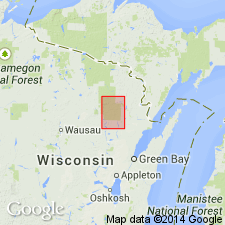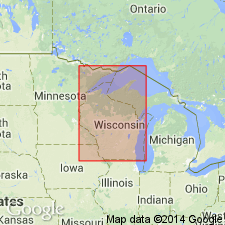
- Usage in publication:
-
- Belongia Granite
- Modifications:
-
- Original reference
- Dominant lithology:
-
- Granite
- AAPG geologic province:
-
- Lake Superior region
Summary:
Pg. 3421. Youngest rocks in McCaslin district, northeastern Wisconsin, are the intrusive High Falls (new) and Belongia Granites. Dominant structure in district is McCaslin syncline which trends approximately east-west. Trough opens to west and appears to close to east but is disrupted by intrusive High Falls granite. Age is Precambrian.
Source: US geologic names lexicon (USGS Bull. 1350, p. 58).

- Usage in publication:
-
- Belongia Granite
- Modifications:
-
- Geochronologic dating
- Dominant lithology:
-
- Granite
- AAPG geologic province:
-
- Lake Superior region
Summary:
Is included as a lithodemic unit of the Wolf River batholith in central and northeastern WI in Lake Superior region. Generalized geologic map shows contacts with undifferentiated Paleozoic rocks, Wolf River Quartz Monzonite (new), Hager Quartz Porphyry (redescribed), Peshtigo Monzonite (redescribed, revised), High Falls Granite, and Precambrian rocks older than 1,450-1,500 m.y. U-Pb concordia intercept age of about 1,500 m.y. is considered most reliable age estimate of the batholith. Coarse-grained equigranular and fine-grained porphyritic varieties described. Coarse-grained granite: mainly subhedral alkali feldspar and idiomorphic quartz, with small amounts of plagioclase and biotite. Locally porphyritic with phenocrysts (35-45 percent) of alkali feldspar and quartz in medium-grained matrix (2 mm). Fine-grained granite: phenocrysts (15-20 percent) of idiomorphic quartz (3-5 mm) and ovoidal alkali feldspar (0.5-2 cm) in fine-grained (1 mm) matrix. Biotite is only mafic mineral; occurs as clusters of grains in matrix. Quartz phenocrysts commonly resorbed; rapakivi texture in minor amounts; granophyric texture, intergrowths of alkali feldspar and quartz surrounding euhedral cores of alkali feldspar, characteristic. Bulk chemical analyses given. Age is Middle Proterozoic.
Source: GNU records (USGS DDS-6; Denver GNULEX).

- Usage in publication:
-
- Belongia Granite*
- Modifications:
-
- Mapped
- Dominant lithology:
-
- Granite
- AAPG geologic province:
-
- Lake Superior region
Summary:
Belongia Granite in Wolf River batholith. Red to pink granite consisting of both a coarse-grained and a fine-grained facies. Probably an epizonal intrusion. Age is Middle Proterozoic.
Mapped in Oconto and Menominee Cos., northeastern WI.
Source: Publication.
For more information, please contact Nancy Stamm, Geologic Names Committee Secretary.
Asterisk (*) indicates published by U.S. Geological Survey authors.
"No current usage" (†) implies that a name has been abandoned or has fallen into disuse. Former usage and, if known, replacement name given in parentheses ( ).
Slash (/) indicates name conflicts with nomenclatural guidelines (CSN, 1933; ACSN, 1961, 1970; NACSN, 1983, 2005, 2021). May be explained within brackets ([ ]).

